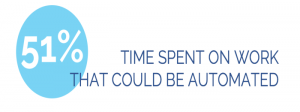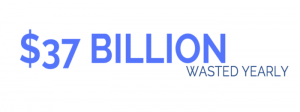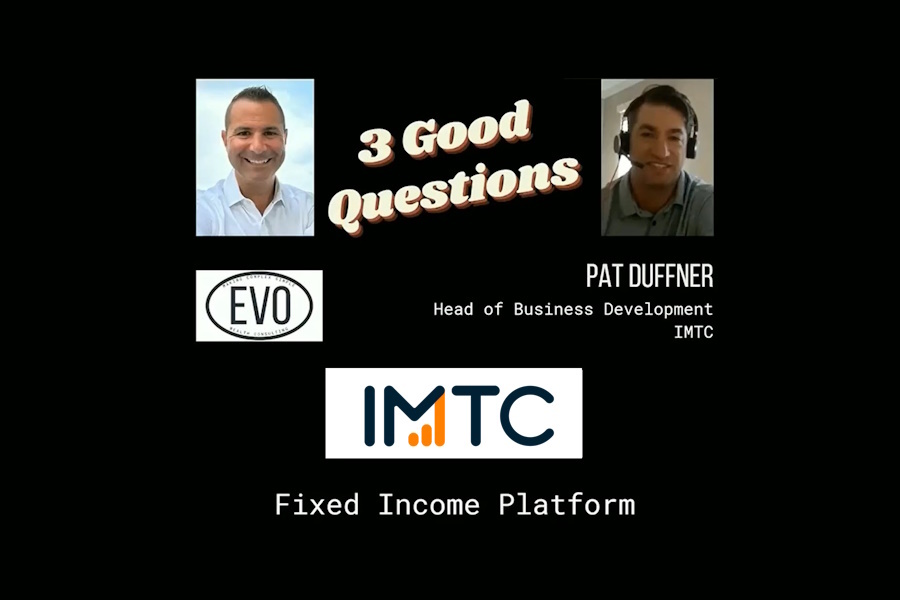5 Reasons You’re Working Late (and How to Get Your Time Back)

Workflow inefficiencies can cost investment managers millions of dollars each year. According to a 2017 study by McKinsey, 80% of workers spent 51% of total working hours on processes that could be automated (collecting data, processing data, and physical activities and operating machinery for predictable or routine tasks). All the while, there are software solutions for many of the tedious, manual tasks we perform daily.
While cost cutting has become a perennial exercise for business leaders in the financial services industry, automation is still a concept that many treat as merely a buzzword. Consider this: KPMG recently reported that robotic process automation can cut costs in financial services by 75%.If the KPMG study is even remotely accurate — this means automation tools could drive a massive impact for your company’s bottom line.
Technological change can reduce costs and enhance employee productivity. However, a good manager must consider not only the operational infrastructure by which she can optimize her team’s performance, but also the cultural norms that are established to guide the team’s interactions.
We have prepared a list of 5 reasons you and your teams are working too late at the office – and propose a few ideas to solve these problems, freeing up capacity and (hopefully) leading to a more productive and engaged workforce.

1. Underutilizing Technology
While headlines make it seem that advancements in AI and machine learning are bounding towards us – contemplating how these technologies actually affect your business can be a mindboggling exercise.
For fixed income managers, utilizing technology to realize operational efficiencies is of particular importance. It is increasingly difficult to find yield in this persistently low interest rate environment. Hunting for alpha while maintaining compliance with ever-changing regulatory demands can exhaust your teams – resulting in unhappy employees and increased headcount turnover. Alleviating capacity constraints enables your team to focus on the important work that they find challenging and engaging. A recent survey by the Aite Group identified operational efficiency and workflow automation as the leading drivers for investing in new portfolio management technology. A solid portfolio management system should provide an efficient solution for performance attribution, order management, and compliance monitoring. Investing in the latest technology will not only help portfolio managers make smarter decisions, but also reduce manual processes, freeing up your team’s capacity. More capacity can translate to happier and more engaged teams. Evaluating your data management systems is another good place to start. Data is becoming a firm’s most valuable asset (aside from employees, of course), so it is crucial to have systems in place to make sure it can be effectively synthesized. This will enable portfolio managers to make more informed investment decisions than ever before. Analytics platforms and data visualization tools are now table stakes for any firm, regardless of the size or life stage of your business — if for no other reason than to save your employees from the chore of using spreadsheets to manually manage portfolio holding information. The right software will allow your teams to refocus that time and energy on high-value priorities like reviewing research, managing projects, or communicating with your clients. Instead of worrying about the robots, investment managers should embrace the technological advancements of our industry and realize the benefits it can provide. Where else can you deploy a technology solution to save time and get home in time for dinner?
- It is no longer necessary to spend hours each week manually preparing presentation materials with graphs and charts to communicate performance with clients. Automated reporting tools allow you to efficiently calculate real-time performance portfolios, streamline distribution of these materials, and maintain closer connectivity with clients. This one single task can save your team days every month.
- Find a more scalable way to check in with your clients regularly by utilizing automated email systems. Your marketing teams can develop email templates to facilitate the on-boarding process, distribute performance reporting, or celebrate investment anniversaries. As a rule of thumb – firms should have some type of touchpoint with clients at least monthly, ensuring your clients know they are top of mind.

2. Too Many Meetings
Unnecessary meetings cost American companies $37 billion in man power every year. If you’re a mid-level portfolio manager, you can expect to spend 35% of your week in the conference room. And if you’re in a C-suite position, that figure ramps up to nearly 50% of your calendar
While there are plenty of valid reasons to meet, small talk and unfocused conversations result in wasted time. Executives say that they consider 67% of meetings to be failures. That means two-thirds of the meeting blocks on your calendar might as well read “don’t bother”. The issue is compounded by the fact that workers spend up to 4 hours every week preparing for these meetings.
Here are a few ways to ensure that your team is making the most of the effort being put into preparing for and attending meetings.
Make the most of your meetings and free up space on your calendar.
- Require an agenda. Agendas should outline topics to be discussed and the key questions that need to be answered during the meeting. If possible, distribute materials 24 hours in advance. This allows you to spend time digesting any new information and review key agenda items, providing an opportunity to assess if your physical presence is necessary.
- Politely decline meetings that you know aren’t going anywhere. Some organizations go as far as putting on extreme gatherings to help those in the room get to the point and then get out.
- Hold the meeting participants accountable. Whether or not you are the leader of your organization, show up prepared for the conversation, with your thoughts in order. This allows you to establish yourself as a valuable asset within your organization.
- Think there might be some relevant information shared at the meeting but you have a conflict? Send a junior member of the team to take notes so you can weigh in as projects progress.
- Summarize major decisions and take responsibility for follow up items. It is useful to send around a list of to-do’s that are delegated to specific meeting participants.
3. Your Organization is Too Siloed
Workflow fragmentation has become a rising concern for portfolio management organizations over the last few years. When it comes to fixed income, a study by World Business Research showed that 81% of respondents were negatively impacted by siloed operations. This can result in teams across an organization struggling to understand firm-wide limits, counterparty exposure and other important risk indicators.
Often people limit their thinking around process improvements to their own personal workflows, reviewing how they move through the day. While this is important, workflow optimization projects should not be limited to analog tasks or exclusively within individual business units. Embracing digital solutions enable closer connectivity across different business groups, reduce bottlenecks, and provide operating leverage.
How can you improve communication and connectivity across your organization?
- Utilize communication solutions like Slack, or project management software like Asana, to manage cross-functional processes and projects in one place – You can easily assign responsibilities and disseminate project updates that are transparent to everyone related to the project.
- Establish periodic, organization-wide check-ins to align priorities and keep all stakeholders informed – whether a team stand-up every morning, or a quarterly all-hands call, these check-ins have been proven to enhance connectivity and reduce operational risk within large organizations.
- Consider how you can consolidate desktop applications or redundant enterprise systems – software should have easy-to-implement APIs that will enable data to flow through your other programs ensuring data quality while minimizing the user interfaces an employee must navigate.
4. Constant Distractions
The average employee is interrupted 56 times a day – that’s 7 times an hour. Factor in the lag time it takes to refocus after an interruption and you are likely to spend 2 hours recovering from distractions every day. This has become such a big problem that workers are now adjusting their work schedules to avoid distractions, arriving to work early or staying late to find uninterrupted periods to complete focused, deep work.
While technology has enabled us to maintain constant connectivity, people seem to be taking the need for immediate knowledge too far. Gloria Mark of the University of California, Irvine, found that a typical office worker gets only 11 minutes between each interruption, while it takes an average of 25 minutes to return to the original task after an interruption.
One of the biggest culprits? Email. Employees check their email 36 times an hour and can spend up to 16 minutes refocusing after handling an inbound email. While financial publications are informative, subscribing to 10 daily newsletters can result in information overload.
It is important to distance yourself from potential distractions so you can sink into a state of deep, focused productivity – this is when you will come up with your best ideas.
Don’t let technology distract you
- Establish a routine with specific times during the day for particular tasks. If possible, use high energy periods to perform more complex, high impact work and utilize energy lows to complete your more mundane responsibilities.
- Only check your email at pre-determined times and let people know your schedule. If something is important, let your colleague or client know they should call. This allows you to focus more intently on the task at hand.
- Schedule “meetings” on your calendar for uninterrupted, focused work time. Let others know not to disrupt you. Even better, silence your phone and head to a room with a closed door or walk over to the local coffee shop.
5. Wasting Peak Hours
Are you an early bird or night owl? Take the time to self-assess when your energy levels are highest and when you are most effective at performing deep, focused work. If you have any flexibility to maintain control over your day, organize tasks that require the most brainpower to periods when you are most high functioning, energized, and alert.
Many PMs prefer to knock out the difficult number-crunching first thing in the morning, then schedule meetings for after lunch when energy levels may be waning. The majority of people are more easily distracted between noon to 4 p.m., setting up meetings during this time frame will force you to stay engaged and focused.
You don’t have to stick to these hours, but as they say, great minds think alike – and one thing most great minds in history have in common: they spent 4 focused hours of their work day leveraging periods of optimal brainpower at their preferred times. Can you carve out 4 hours for peak focus? Use these hours to complete your most engaging work. Then, use the remainder of the day to catch up on other responsibilities that can be accomplished passively.
Focus is a Finite Resource – Use it Wisely
- Spend your most alert hours tackling the toughest problems, making high-level decisions and strategizing. Spend the rest of the day responding to emails, catching up on those research papers or daily news articles you’ve been meaning to read, and following up with clients.
- Even better, take some time in the afternoon to get out of the office and go for a walk to clear your mind. This reduces stress levels and to flood the mind while on the move.
Scale Your Impact
Managing an effective organization first requires you effectively manage yourself. As mentioned, reducing operational cost and improving profitability were the top two priorities for fixed income professionals in 2018. Embracing these tips are a surefire way to improve the operating environment for your team, while mitigating those late nights at the office.
Set your day up for success by scheduling around your peak productivity levels, carving out blocks of time for deep work, prioritizing important tasks, and avoiding distractions. Make it a routine to identify tasks and workflows you can delegate, giving others in your organization a chance to take on new responsibilities. Wherever possible, automate. This will save time and reduce risk – less manual data entry inevitably means fewer human errors, resulting in higher productivity and profit.
Set yourself up for success and use your free time for high value work… you may even be done in time for happy hour. Click here to learn how we can help.





